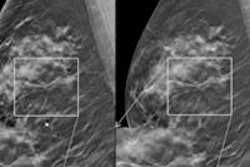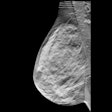When added to mammography, digital breast tomosynthesis (DBT) reduces overall recall rates in breast cancer screening by 30%, with even greater reductions for women younger than 50 and those with dense breasts, according to a new study published online in Radiology.
Researchers from Yale University School of Medicine compared screening recall rates and cancer detection rates in two groups of women: those who received conventional digital mammography alone and those who had tomosynthesis in addition to mammography (Radiology, July 30, 2013).
"Although all breast density and age subgroups benefited from the addition of tomosynthesis to conventional digital mammography, the patients receiving the greatest benefit were women with dense breasts and those younger than 50 years," wrote Dr. Brian Haas, Dr. Liane Philpotts, and colleagues.
The study included 13,158 patients who underwent screening mammography, and 6,100 received tomosynthesis. The addition of tomosynthesis resulted in a 30% reduction in the overall recall rate, from 12% for mammography alone to 8.4% in the tomosynthesis group.
Recall rates were reduced even further for women with dense breast tissue and for women younger than 50, Haas and colleagues found.
| Recall rates by breast tissue type | |||
| Tissue characteristic | Recall rate with mammography alone |
Recall rate with mammo plus DBT |
Difference |
| Scattered fibroglandular density | 10.6% | 7.9% | 25% |
| Heterogeneously dense breasts | 16.7% | 10.2% | 39% |
| Extremely dense breasts | 15.6% | 6.7% | 57% |
| Recall rates by age | |||
| Age | Recall rate with mammography alone |
Recall rate with mammo plus DBT |
Difference |
| < 40 | 25% | 11% | 56% |
| 40-49 | 16.3% | 10.4% | 36% |
The cancer detection rate was 5.7 per 1,000 in patients receiving tomosynthesis, compared with 5.2 per 1,000 in patients receiving mammography alone. The difference was not statistically significant, probably because the study was "underpowered to demonstrate small differences in the cancer detection rate," the authors wrote.
Lower mammography recall rates translate into multiple benefits, according to Haas and colleagues.
"The value of decreasing screening mammography recall rates is immense," they wrote. "In particular, the greatest benefits are seen in younger patients and those with dense breasts, precisely the population in which conventional mammography is most limited. Decreased recall rates can be directly translated into less patient anxiety and decreased costs for additional diagnostic examinations."
Tomosynthesis does have a downside, however: Its radiation dose is double that of digital mammography alone. But new technology cleared in May by the U.S. Food and Drug Administration (C-View 2D imaging software, Hologic) could eliminate the need for the conventional 2D image in addition to the tomosynthesis images, Haas and colleagues wrote.
Radiation dose notwithstanding, tomosynthesis for screening mammography is very promising, the researchers concluded.
"Tomosynthesis promises to alter the mammography workflow by decreasing screening recall rates and to subsequently improve the mammography experience for many women," they wrote.




















